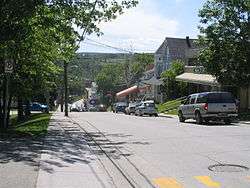Windsor, Quebec
| Windsor | |
|---|---|
| City | |
 | |
 Location within Le Val-Saint-François RCM. | |
 Windsor Location in southern Quebec. | |
| Coordinates: 45°34′N 72°00′W / 45.567°N 72.000°WCoordinates: 45°34′N 72°00′W / 45.567°N 72.000°W[1] | |
| Country |
|
| Province |
|
| Region | Estrie |
| RCM | Le Val-Saint-François |
| Constituted | December 29, 1999 |
| Government[2] | |
| • Mayor | Sylvie Bureau |
| • Federal riding | Richmond—Arthabaska |
| • Prov. riding | Richmond |
| Area[2][3] | |
| • Total | 15.00 km2 (5.79 sq mi) |
| • Land | 14.29 km2 (5.52 sq mi) |
| Population (2011)[3] | |
| • Total | 5,367 |
| • Density | 375.5/km2 (973/sq mi) |
| • Pop 2006-2011 |
|
| • Dwellings | 2,409 |
| Time zone | EST (UTC−5) |
| • Summer (DST) | EDT (UTC−4) |
| Postal code(s) | J1S 2L7 |
| Area code(s) | 819 |
| Highways |
|
| Website |
www |
Windsor is a town of 5,300 people, part of the Le Val-Saint-François Regional County Municipality in the Estrie region of Quebec, Canada, of which it is the seat.
History
Apart from the Abenaki Indian camps in this area in the 1600s, Windsor was unpopulated until the early 19th century, when Governor General Prescott granted a tract of land to Joseph Brown to thank him for his service to the Crown. In 1876, when French-Canadian colonist Michel Cloutier acquired land, a rift grew between Francophones and Anglophones, with one side locating in the Township municipality and the other in the village of Windsor Mills. Windsor Mills was elevated to town status in 1899, and took its current name in 1914. The name originates from the village of Berkshire, where Windsor Castle, built ca. 1344 at the request of King Edward III, is located. While most of Windsor’s economy is built on the pulp and paper industry and textile manufacturing, there are also some worthy attractions. This includes the Poudrière de Windsor, which manufactured black explosive powder in Canada around 1864.
During World War II the Royal Canadian Air Force built and operated No. 4 Elementary Flying Training School as part of the British Commonwealth Air Training Plan [4] near Windsor. The school opened on 34 June 1940 and closed on 25 August 1944. The airfield was located southwest of the town near 45°31′00″N 072°02′12″W / 45.51667°N 72.03667°W[5]
Windsor is perhaps best known for its ultra-modern Domtar fine paper plant.
Demographics
Population
| Historical Census Data - Windsor, Quebec[6] | |||||||||||||||||||||||||||||
|---|---|---|---|---|---|---|---|---|---|---|---|---|---|---|---|---|---|---|---|---|---|---|---|---|---|---|---|---|---|
|
|
| |||||||||||||||||||||||||||
(A) adjusted figure due to amalgamation of the town of Windsor and the village of Saint-Grégoire-de-Greenlay on December 29, 1999. | |||||||||||||||||||||||||||||
Language
Mother tongue (2011)[3]
| Language | Population | Pct (%) |
|---|---|---|
| French only | 5,120 | 96.1% |
| English only | 165 | 3.1% |
| English and French | 35 | 0.7% |
| Non-official languages | 10 | 0.2% |
See also
- Le Val-Saint-François Regional County Municipality
- Estrie, administrative region in Quebec
- List of cities in Quebec
References
- ↑ Reference number 67322 of the Commission de toponymie du Québec (French)
- 1 2 Geographic code 42088 in the official Répertoire des municipalités (French)
- 1 2 3 "(Code 2442088) Census Profile". 2011 census. Statistics Canada. 2012.
- ↑ Hatch, F. J. (1983). The Aerodrome of Democracy: Canada and the British Commonwealth Air Training Plan, 1939-1945. Ottawa: Directorate of History, Department of National Defence. ISBN 0660114437.
- ↑ Air Navigation Edition Ottawa-Montreal (Map) (September 1942 ed.). Cartography by Hydrographic and Map Service. Canada Department of Mines and Resources, Surveys and Engineering Branch.
- ↑ Statistics Canada: 1996, 2001, 2006, 2011 census
 |
Val-Joli |  | ||
| |
||||
| ||||
| | ||||
| Saint-François-Xavier-de-Brompton |